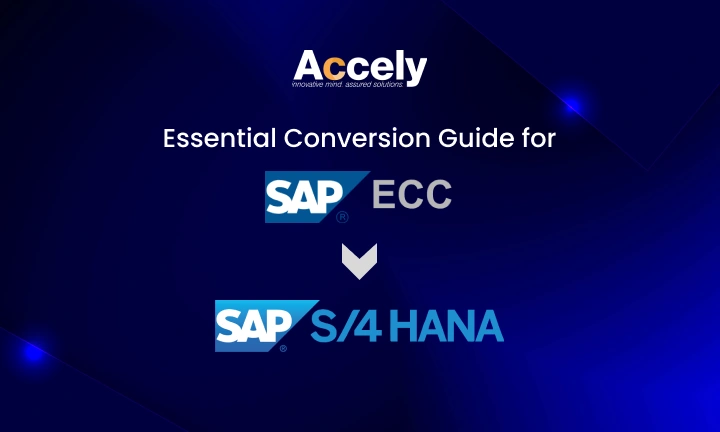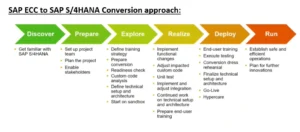Changing the way your business can be an intimidating prospect, especially when it comes to an aging ERP software. While staying put with the change (under such situations) might seem the best option, it’s not.
‘Adapting’ in the face of change is the only way businesses can grow and keep up with the competition. Constant growth demands an equally consistent approach to adapting to a change.
Keeping the same in mind, SAP upgraded its ECC offering from the ground up to develop what we know today as the SAP S/4HANA.
S/4HANA is more than just a 360-degree ERP support today. Since its inception in 2015, severe yearly updates have brought us new and better features for improved performance and analytical abilities.
However, the journey of SAP ECC to SAP S/4HANA migration continues to be a trend at large. So to help you better, we’ve covered a complete journey from SAP ECC to SAP S/4HANA in this blog article.
Continue reading as we explore the different aspects of both platforms to help you understand what your organization has been missing out on.
SAP ECC VS. SAP S/4HANA: Generational Difference
Simply put, SAP S/4HANA, the most recent version of SAP’s software, operates on the SAP HANA database. Unlike HANA, SAP’s in-memory platform and other SAP software were initially backed by external databases like Oracle, making it possible for businesses to obtain and analyze data quickly and efficiently.
As a result, SAP HANA has developed into a platform for customer-defined applications in software development. SAP HANA has evolved into a system where data storage and retrieval are a response to application requests. The program has ETL (transform, load, extract) capabilities and can easily do complex analytics.
However, that’s not all. The primary distinction between SAP ECC and S/4HANA is that ECC is the fundamental ERP solution inside the SAP Business Suite. In contrast, HANA is an in-memory database that works well in the cloud and is developed to handle multiple aspects of transactions and analytics on a single platform.
Then, how do SAP HANA and ERP vary from one another? Let’s find out:
| SAP ECC | SAP S/4HANA | |
| Smart Technologies | – | Comprises all the innovative technologies including AI, ML, advanced analytics, and digital assistants with voice recognition. |
| Data Model Type | Complex. Redundant tables lead to blocking and maintenance issues. | Simple & effortless. This model combines smart technologies like analytics, transactions, maintenance, reduced reconciliation, and blocking. |
| Database | Operates over a disk | Leverages SAPs in-memory cloud architecture. |
| UI | SAP GUI (Legacy Graphical User Interface) | SAP Fiori – Easily customizable modern and intuitive UI. |
| Deployment modes | On-premise | Multiple approach choices like on-premise, cloud, or hybrid setup. |
| Road Map | Supported till 2027 | Effective till 2040 |
Looking at this comprehensive overview of the primary distinctions between SAP ECC and S/4HANA, it’s evident that S/4HANA is a completely new approach to business (as we know). Therefore, organizations that are yet to must opt for ECC to S/4HANA migration.
But, how to migrate to this new-age ERP function? Let’s find out in a detailed overview of the process, explained in the following sections.
Implementing the SAP S/4HANA Update
The extra value that SAP S/4HANA migration can add to your operations increases as your understanding of the relevance of SAP’s digital core. The fundamental idea behind SAP S/4HANA is its commitment to empowering businesses to meet the challenges of the 21st century. Therefore, limiting oneself to a simple technical upgrade of current systems and environments would not be sufficient.
You should evaluate how your processes have changed and if your system landscape will be viable in the future or whether its current structure has to be changed. Therefore, when performing the implementation, you need to consider the following aspects:
Technical Implementation
A migration’s technical execution mostly entails moving the database to SAP HANA, updating the software, converting data models to the SAP S/4HANA data model, and setting up the frontend server for SAP Fiori interfaces. Some technical changes might also be needed to develop your system’s current custom code.
Since they can be carried out quickly with the appropriate tools and are not often depends on the scope of later usage in production. These activities may be technically supported and regulated. As a result, SAP offers a wide range of tools for organizing and implementing this technological change.
Process-Oriented Implementation
Process-oriented migration involves adding new apps and changing how current business processes are represented in the system. Only a portion of these adjustments to business procedures is made within the system itself. Most of the time, you are limited to entering indications, such as altered configuration information.
But when it comes to planning, you’ll need to take much more extensive measures for change management. These processes of SAP Cloud Migration include developing your new, modified business process, setting up appropriate safeguards, educating users, granting roles and permissions, conducting a trial project, and changing the production system.
Conversion Phases to SAP S/4HANA
Now that you know the different implementation approaches, let’s look at the conversion phases associated with the process.
Source: https://blogs.sap.com/
- Pre-Conversion and Detailed Assessments
Simplifying the items’ resolution is a pre-conversion activity. This is because a majority of the actions on the logistics side take place before conversion. Besides, this step also includes the post-conversion process for finance.
When the system is converted, SAP Gold partners conduct detailed assessment sessions with the clients to inform them of any potential changes that may influence the business process, either directly or indirectly.
- Fit-Gap Analysis
This significant turning point is when consumers are fully informed about the changes and how they will affect a business. Then, the client should be given a chance to choose whether they want to move forward with the ‘To-Be’ process or if they are ‘OK’ with the present environment. In addition, they should also be chosen if they want to do it as-is by explaining specific optional adjustments that are a part of conversion in the As-Is and To-Be formats.
The Fiori apps are a significant decision that must be addressed and made. After conversion, some FI transactions would no longer be used and would be replaced by Fiori. Customers can build Fiori apps in addition to the required applications for transactions that SAP S/4HANA still supports. If you look at it, these analysis sessions are a good time to have these conversations.
- Software Upgrade Manager (SUM)
Once the basis team has completed addressing and identifying the Simplification Items, the next step involves launching the SUM (Software Upgrade Manager) tool. This multifunctional tool supports several processes, including enhancement packages, release upgrades, updating individual components on NetWeaver, and using support package stacks.
Realizing the Benefits of SAP S/4HANA Migration
RISE with SAP, SAP’s most recent offering, offers a comprehensive vision of a complete cloud service offering through SAP S/4HANA. It’s intended to support the creation of an intelligent company. Through SAP S/4HANA, more tools are available that may help you build a roadmap or business case for your company.
Besides, once you’ve followed the implementation process, here are some unique advantages that your business may now be able to reap:
- Unique Approach to Business: By utilizing the new and enhanced digital business processes offered by S/4HANA, organizations may potentially boost overall productivity, save expenses, and boost bottom-line income. With SAP supporting further S/4HANA improvements, associated gains will only increase.
- Enhanced User Experience: Along with proactive insights, embedded analytics, user domain cockpits, and SAP’s new user interface, SAP Fiori, offers a variety of other advantages. It encourages SAP S/4HANA migration by pushing notifications and information to users.
- Real-Time Connectivity: The epidemic has made the highly mobile and interconnected globe more cohesive. So, no matter where you are, the cloud features of S/4HANA provide increased business process monitoring and real-time analytics.
- Better Data & Predictive Analysis: The main distinction of S/4HANA is predictive analytics. Your organization gains a competitive edge through increased access and analysis that antiquated systems cannot. Real-time insights are provided to your company, so problems and disputes may be foreseen before they arise.
- Improved Decision Making: The innovators of today may be the ones lacking behind tomorrow in no time. Therefore, to make wise judgments, world leaders must insist on knowing all of their possibilities. The toolset of SAP S/4HANA provides concrete insights that help enhance operational decision-making.
Conclusion
Businesses must opt for the SAP S/4HANA migration before 2027. Therefore, corporations must begin making plans for this migration journey immediately. If not, making decisions at the last minute could result in a stressful and challenging journey. As we come closer to this deadline, many last-minute conversion projects may also cause a lack of skilled consultants. Therefore, when putting together a strategy for system conversion, there is a lot to consider. Remember, if your corporation has already moved to the SAP S/4HANA cloud before the 2027 deadline, it’s only a matter of time till you become the next big thing in your business.






